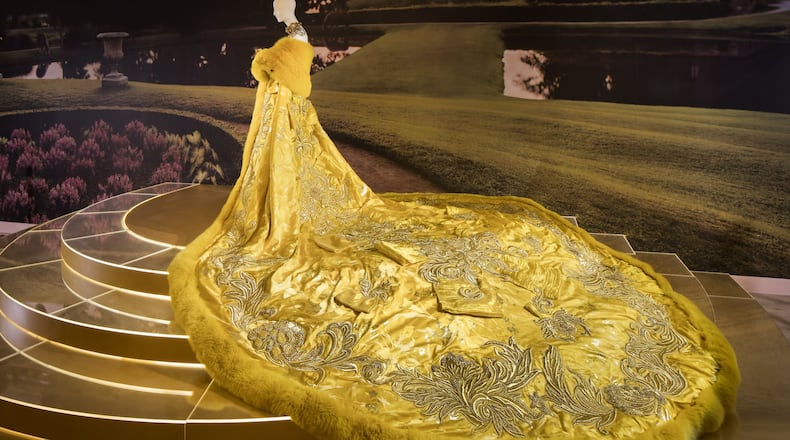By turns fascinating and strangely alienating, the haute couture creations from Chinese fashion designer Guo Pei in the SCAD FASH Museum of Fashion and Film exhibition "Guo Pei: Couture Beyond" are, on the surface, undeniably astounding. The first solo U.S. exhibition devoted to her work, this SCAD FASH show is a bit of a coup for the museum, a high-profile show that has already garnered attention from The New York Times and fawning previews in the fashion press.
Elaborate, architectural constructions of endless layers of pleated fabric, bejeweled 16-foot trains that sweep the floor with the drama of a monarch’s coattails and dresses festooned with copious sequins, embroidery and iridescent paillettes, Guo’s gowns are symphonies of workmanship (dresses can often take years to execute) and whimsy that often overturn our vision of what a skirt or a dress can be. The undercarriages of skirts in her “Garden of Soul” collection drip bejeweled flowers like an inverted garden, and in another dress, an explosion of red silk flowers turns darker and darker as they near the hem of the dress in an ombre effect that ends in a rich, dramatic eggplant color.
Modeled on the blue-and-white designs of Chinese porcelain or festooned with the dragons, lotuses, butterflies, pagodas and peonies that ornamented the robes of Chinese royalty, Guo’s garments hark back to imperial China. In this way, the garments strike a strangely anachronistic note, at times shockingly modern with their punk rock spiked shoulders, micro-minis and platform shoes and at other moments so rich in ornamentation that Guo’s clothes can seem like vestiges of a lost, more formal age than our own.
Included in the show is Rihanna’s gorgeous acid-yellow dress with 55 pounds of silk and dyed fox fur that the singer famously swanned down the Metropolitan Museum of Art’s Costume Institute Gala red carpet in 2015. Though Guo has expressed interest in creating a more accessible ready-to-wear line, for now wealthy risk takers like Rihanna but also the lesser-known Chinese elites and the global 1 percent are the only takers for these clothes with their mortgage-equivalent price tags.
But Guo’s gowns also raise questions about the vision of femininity and wealth privileged in these garments. A video of a Guo Pei runway show where models look like the foot-bound courtesans and noblewomen of ancient China hobbling with the aid of helpers on stilt-like shoes down the catwalk only amplify this strange vision of feminine charm. Guo’s vertiginous high heels mimic Qing Dynasty chopine footwear, which also slowed down and complicated their wearers’ movement. Are these garments armor from the world, or a prison of wealth? Guo’s erotics of incapacitation are so extreme even a fashion rebel like Lady Gaga reportedly turned down one of Guo’s dresses for a music video because she found she couldn’t move in it.
A gown of exquisite gold columns like a suit of armor, woven into a bell-like skirt, “Magnificent Gold,” required 50,000 hours of embroidery to assemble, attesting to the economic excesses that define haute couture in a time of dramatic social divide.
Or as Judith Thurman wrote in her New Yorker profile of Guo, calling her the court dressmaker to this moneyed elite, “China’s rich think of themselves as a new aristocracy.” With their blatantly regal associations, Guo’s garments attest to a new world order defined not by the divinity of birth or ruling dynasties, but by capital.
ART REVIEW
“Guo Pei: Couture Beyond”
Through March 4, 2018. 10 a.m.-5 p.m. Tuesdays-Wednesdays and Fridays-Saturdays; 10 a.m.-8 p.m. Thursdays; noon-5 p.m. Sundays. Closed Thanksgiving Day and the day after. $10; $8, seniors and military (all active-duty military personnel and their families have free museum admission through Labor Day); $5, college students with ID and SCAD alumni; free, children under 14 and SCAD students/faculty/staff. SCAD FASH, 1600 Peachtree St. NW, Atlanta. 404-253-3132, www.scadfash.org.
Bottom line: Astounding in their beauty but troubling in their implications, Chinese designer Guo Pei's clothes are a blend of history and a reflection of the strange, economically divisive times we live in.
About the Author







